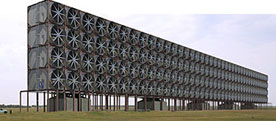Another XPRIZE competition has been announced, this time awarding $20 million to researchers who Reimagine Carbon.
Carbon XPRIZE challenges researchers to develop products that can be made from capturing carbon emissions from coal and natural gas. Research shows there is potential for a wide range of products, such as raw materials for chemicals and plastics; building materials; and fuels. "These technologies have the potential to transform how the world approaches carbon mitigation, and to reduce the cost of managing carbon," they say.
The prize will be awarded in 2020, and is sponsored by obvious benefactors – Canada’s Oil Sands Industry Alliance and NRG Energy.
The idea is to accelerate research that’s already underway around the world. It makes much more sense than capturing carbon and burying it underground – an expensive process that hasn’t been proved will work over the long term. Many believe carbon gases will escape back into the atmosphere.
Several countries have started subsidizing this kind of research over the past five years, such as Germany ($110 mllion a year since 2009); US Department of Energy (DOE) ($106 million) and China ($4.7 billion over the next five years) will focus on recycling carbon emissions from the coal, steel, cement and paper industries, reports Nature.
Researchers have two basic problems to solve: how to turn carbon emissions into new products without using lots of energy – or only using clean energy; and making sure those products don’t quickly emit carbon gases back into the atmosphere.
The XPRIZE Foundation has been awarding prizes for competitions that encourage solving the world’s Grand Challenges since 1995. Its motto is "Making the Impossible Possible." An XPrize on measuring ocean acidity was awarded in July.
Examples of Carbon Product research underway:
- DOE’s "Fuels from Sunlight Energy Innovation Hub" is developing solar-based transportation fuel from carbon;
- Carbon Engineering broke ground on a demonstration plant that converts carbon vacuumed from the atmosphere into biofuels;

- Australian researchers are working on solar sponges;
- Massive ocean seaweed farms would reverse acidification and suck carbon dioxide out of the atmosphere.
Seaweed grows 30-60 times faster than terrestrial plants, offering a super-charged way to draw carbon from the air. out lots of C02. A study finds if 9% of oceans were covered, it would absorb the entire world’s annual emissions, while providing protein for 10 billion people.
About 500 square kilometers of seaweed farms off the coast of China have been well-studied, showing the pH much higher than surrounding areas, Australian scientist Tim Flannery, told Yale 360.
- Widespread adoption of carbon fiber technology would remove carbon from the air and turn it into cars and other industrial products.
- Giant chiller boxes in Antarctica would super-freeze the frigid air, producing "carbon snow" that could be sequestered in the continent’s massive ice sheet.
Australian scientist Tim Flannery expounds on these "third way technologies" in his book, Atmosphere of Hope. Unlike geoengineering, they "strengthen Earth’s own self-regulatory system by drawing C02 out of the atmosphere in ways the planet naturally does already." Along with serious carbon reductions, if these technologies can be scaled quickly enough, there may be light at the end of the climate tunnel, he told Yale 360.
Read his interview for inspiration:

The Xprize for monitoring ocean acidification has already been awarded at a ceremony in NYC this past July.